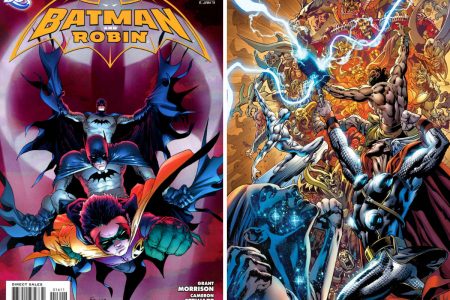Kill Shakespeare #1–6
Written and created by Conor McCreery and Anthony Del Col
Illustrated by Andy Belanger
Coloured by Ian Herring
Lettered by Chris Mowry, Robbie Robbins and Neil Uyetake
Edited by Tom Waltz
Published by IDW Publishing
The creators describe Kill Shakespeare as a mix of The League of Extraordinary Gentlemen, Fables and The Lord of the Rings (although I think they’re stretching it with The Lord of the Rings), and there is some truth in it: they use characters from the works of William Shakespeare to tell a completely original tale, which is a great idea. However, a high concept alone isn’t enough – you have to use a high concept to tell a good story.
This trade paperback collects the first six issues of the twelve-part story, which starts with Hamlet in the middle of his play: haunted by ghosts after killing Polonius and banished to England with Rosencrantz and Guildenstern. However, pirates attack and Hamlet is knocked overboard. He wakes up to be discovered by Richard the Third, who portrays himself as a benevolent ruler to Hamlet as he introduces him to the three witches, who have a prophecy concerning Hamlet (calling him ‘The Shadow King’) and the evil wizard William Shakespeare, someone only Hamlet can find. Richard promises Hamlet to return his dead father to life if Hamlet retrieves Shakespeare’s quill, so they set off on the quest, where they are joined by Iago and Richard reveals his true colours to the readers but not Hamlet.
A night-time attack leads to Hamlet being rescued by Falstaff, who introduces him to Juliet and Othello. Juliet is travelling the land to incite rebellion against Richard and Macbeth, under the good name of Will Shakespeare (who is treated almost like a deity of some sort by those against Richard). They are attacked by Don John, commanded by Richard to kill them, leading to a large fight in which Iago proves himself helpful to Hamlet, leading to an uneasy alliance between an enraged Othello and Iago. However, Hamlet decides to strike out on his own to find his own path among the talks of destiny and the Shadow King. This leads him to encounter Demetrius, Lysander and and Adriana, but he eventually meets up again with Juliet and the rest, where he messes up talking with Adriana, angsts a bit about his life (he is Hamlet, after all), but eventually finds his courage in conflict, which leads to the start of the uprising.
This is a compelling narrative with all the elements of a good story. There are good characters (well, they have been stolen from an excellent source), excitement, treachery, betrayals, courage and even humour: Falstaff and ‘lusty wenches’ talk in Shakespearean double entendre (about wicks and tallows quill-dipping and women), the pubs are called The Merry Wives of Windsor and The Bottoms Up, and there is a rubbish escape plan involving disguising as women (‘I saw it in a play once … of course, it did end in tragedy’). There are other Shakespeare characters, such as Puck and Lady Macbeth (who is working her magic behind the scenes), and there are probably lots of references that I am missing because I’m not a Shakespeare expert – I think I recognise some dialogue that is either direct quotes or riffs on quotes – so the writers have done their homework and put in the effort to reference the works they are using to tell a new adventure. The only time it doesn’t work is when it tries too hard to use Shakespearean language for the new sections – Juliet’s inspiring speech comes off badly in this regard and doesn’t capture the right flavour. It sounds better when it keeps the dialogue simple and then brings in the occasional quote.
The art is a mix of a cartoony style with a Vertigo edge (the colouring can be a little on the dark side at times), with an occasional inconsistency in the faces between panels, but Belanger does a good job of storytelling that has to cover a lot of talking heads with bits of ghostly interaction and magic and fighting (there is a fair smattering of blood and violence in some of the issues). It feels a little rough when reading the first issue, but acclimatisation to the style happens quickly and it feels completely appropriate for the story – a slicker version wouldn’t have captured the time period, and rougher form of linework wouldn’t have encapsulated the many different characters so clearly.
This isn’t supposed to be Shakespeare, which is what I think some reviewers have confused it for, believing it should be another sort of book adhering to Shakespeare’s style and storytelling. This is an enjoyable adventure that incorporates characters from his works into something completely different – I look forward to seeing how the story finishes and if we get to meet Will himself.




